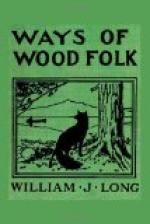There was a prize in the old blind evidently. But what was he doing there? Till then I had supposed that the owl always takes his game from the wing. Farther along the beach was a sand bluff overlooking the proceedings. I gained it after a careful stalk, crept to the edge, and looked over. Down in the blind a big snowy owl was digging away like a Trojan, tearing out sand and seaweed with his great claws, first one foot, then the other, like a hungry hen, and sending it up in showers behind him over the old mast. Every few moments he would stop suddenly, bristle up all his feathers till he looked comically big and fierce, take a look out over the log and along the beach, then fall to digging again furiously.
I suppose that the object of this bristling up before each observation was to strike terror into the heart of any enemy that might be approaching to surprise him at his unusual work. It is an owl trick. Wounded birds always use it when approached.
And the object of the digging? That was perfectly evident. A beach rat had jumped down into the blind, after some fragments of lunch, undoubtedly, and being unable to climb out, had started to tunnel up to the surface. The owl heard him at work, and started a stern chase. He won, too, for right in the midst of a fury of seaweed he shot up with the rat in his claws—so suddenly that he almost escaped me. Had it not been for the storm and his underground digging, he surely would have heard me long before I could get near enough to see what he was doing; for his eyes and ears are wonderfully keen.
In his southern visits, or perhaps on the ice fields of the Arctic ocean, he has discovered a more novel way of procuring his food than digging for it. He has turned fisherman and learned to fish. Once only have I seen him get his dinner in this way. It was on the north shore of Nantucket, one day in the winter of 1890-91, when the remarkable flight of white owls came down from the north. The chord of the bay was full of floating ice, and swimming about the shoals were thousands of coots. While watching the latter through my field-glass, I noticed a snowy owl standing up still and straight on the edge of a big ice cake. “Now what is that fellow doing there?” I thought.—“I know! He is trying to drift down close to that flock of coots before they see him.”
That was interesting; so I sat down on a rock to watch. Whenever I took my eyes from him a moment, it was difficult to find him again, so perfectly did his plumage blend with the white ice upon which he stood motionless.
But he was not after the coots. I saw him lean forward suddenly and plunge a foot into the water. Then, when he hopped back from the edge, and appeared to be eating something, it dawned upon me that he was fishing—and fishing like a true sportsman, out on the ice alone, with only his own skill to depend upon. In a few minutes he struck again, and this time rose with a fine fish, which he carried to the shore to devour at leisure.




